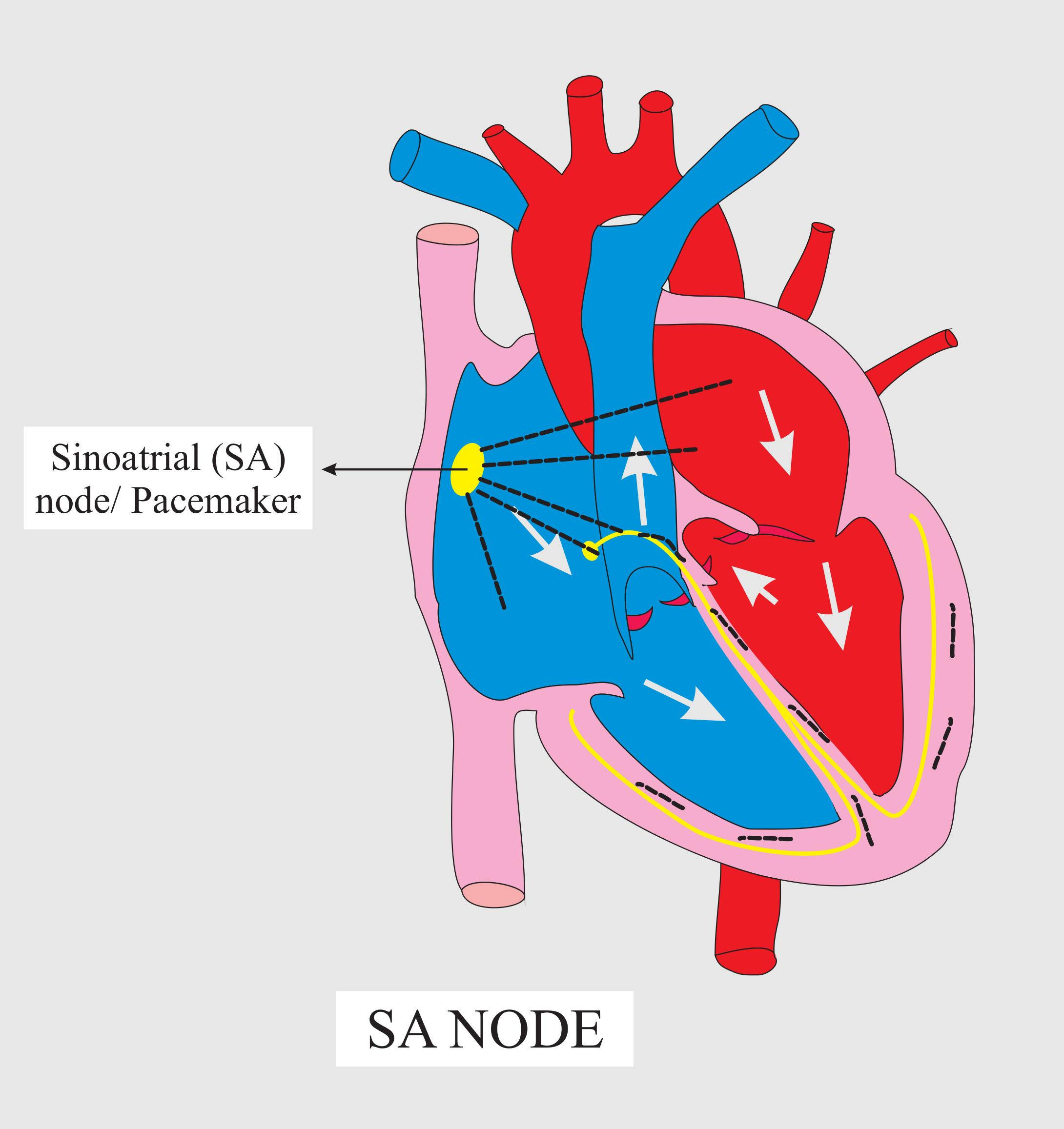
Pacemaker (SA Node) of the heart is situated
(a)In the wall of the right atrium close to the eustachian valve
(b)On Intra- auricular septum
(c)On interventricular septum
(d)In the wall of the left atrium close to the opening of pulmonary veins
Answer
484.5k+ views
Hint: The heart is a muscular organ that pumps blood throughout the body through blood vessels of the circulatory system. The blood carries oxygen and nutrients to the body and metabolic waste to the lungs. It is located between the lungs in the middle compartment of the chest and is a size of a closed fist.
Complete answer:
The pacemaker of the heart is situated in the right wall of the atrium close to the eustachian valve. A sinoatrial node is a group of cells that produce an electric impulse that travels throughout the heart through an electrical conduction system. The sinoatrial node causes rhythmic contraction of the heart so that it continues action potential which is known as the heart’s natural pacemaker. The size varies between 10 to 30 millimetres and is 5-7 mm wide with 1-2 mm deep. The cells of the sinoatrial node are spread throughout the body with a connective tissue containing nerves, collagen, blood vessels, and fat.
Additional information: The blood supply for the sinoatrial node is received from the sinoatrial nodal artery which varies between the individuals. It originates as a branch of the right coronary artery that has arisen from the circumflex artery in some individuals. It passes through the superior vena cava. It does not consist of large veins that drain the blood away from the sinoatrial load and is known as the venous drainage. It allows the movement of charged atoms created by the membrane potential and non-pacemaker cells have a relatively constant membrane potential in the absence of stimulation which is known as resting potential.

So, the correct answer is 'In the wall of the right atrium close to the eustachian valve'.
Note: The human heart beats about 115000 times a day and pumps about 2000 gallons of blood every day. If it gets disconnected from the body it will continue beating. The largest heart among the mammals is of the Whales.
Complete answer:
The pacemaker of the heart is situated in the right wall of the atrium close to the eustachian valve. A sinoatrial node is a group of cells that produce an electric impulse that travels throughout the heart through an electrical conduction system. The sinoatrial node causes rhythmic contraction of the heart so that it continues action potential which is known as the heart’s natural pacemaker. The size varies between 10 to 30 millimetres and is 5-7 mm wide with 1-2 mm deep. The cells of the sinoatrial node are spread throughout the body with a connective tissue containing nerves, collagen, blood vessels, and fat.
Additional information: The blood supply for the sinoatrial node is received from the sinoatrial nodal artery which varies between the individuals. It originates as a branch of the right coronary artery that has arisen from the circumflex artery in some individuals. It passes through the superior vena cava. It does not consist of large veins that drain the blood away from the sinoatrial load and is known as the venous drainage. It allows the movement of charged atoms created by the membrane potential and non-pacemaker cells have a relatively constant membrane potential in the absence of stimulation which is known as resting potential.

So, the correct answer is 'In the wall of the right atrium close to the eustachian valve'.
Note: The human heart beats about 115000 times a day and pumps about 2000 gallons of blood every day. If it gets disconnected from the body it will continue beating. The largest heart among the mammals is of the Whales.
Recently Updated Pages
Master Class 11 Business Studies: Engaging Questions & Answers for Success

Master Class 11 Accountancy: Engaging Questions & Answers for Success

Master Class 11 Computer Science: Engaging Questions & Answers for Success

Master Class 11 English: Engaging Questions & Answers for Success

Master Class 11 Social Science: Engaging Questions & Answers for Success

Master Class 11 Economics: Engaging Questions & Answers for Success

Trending doubts
Which one is a true fish A Jellyfish B Starfish C Dogfish class 11 biology CBSE

State and prove Bernoullis theorem class 11 physics CBSE

1 ton equals to A 100 kg B 1000 kg C 10 kg D 10000 class 11 physics CBSE

In which part of the body the blood is purified oxygenation class 11 biology CBSE

One Metric ton is equal to kg A 10000 B 1000 C 100 class 11 physics CBSE

Difference Between Prokaryotic Cells and Eukaryotic Cells




